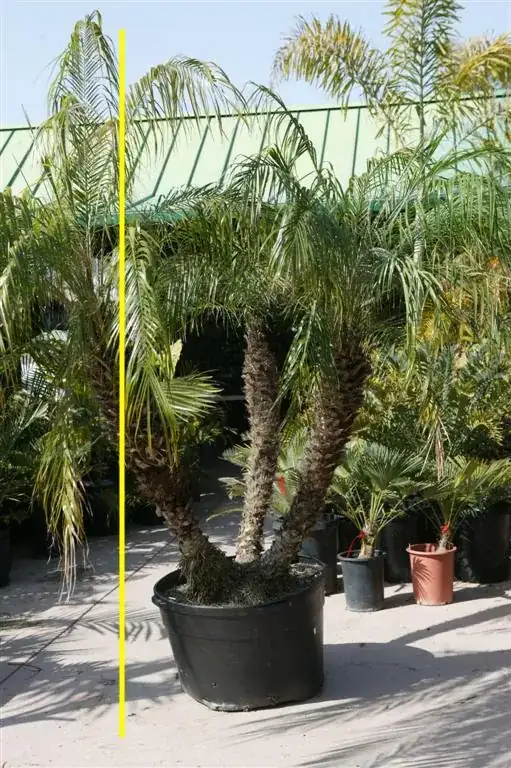My neighbor planted a pygmy date palm cluster fairly close to our common property line. Although the roots and cluster base are entirely on the neighbor's property, one of the trees in the cluster grows diagonally over the property line, such that all of the palm branches occur on our side of the property line.
I am aware that I am allowed to trim vegetation that crosses the property boundary; however, I am not allowed to perform trimming that would kill the tree. In this case, trimming the portion of the tree over the line would definitely kill it.
Can I compel my neighbor to have the tree removed (or relocated, at their discretion)? We are located in Florida, US, if that is pertinent to the answer.
I don't have an image of the actual plantings in question, but below is a good approximation of the size of the plantings, and degree that the tree crosses the boundary line (yellow line). Our property would be to the left of the line, neighbor's to the right. (For clarification, the trees are planted in ground, and there is no concrete around the property line; this is just an example image I found that approximates the size of the trees)
Background: My neighbor has complained that our landscaping/lawn maintenance company has crossed the property line during their work. Our landscaper disputes the neighbor's claims, but allows that they may have inadvertently stepped over the property line. This is possible, but not likely, as the neighbor's plantings are low, and it would be difficult to trim their plantings that cross the line from slightly over the line. Not to mention, pointless, as it is easier to trim the encroaching plants entirely from our property, than it is to stand on or near the property line.
Notwithstanding our neighbor's claim, he has crossed entirely to our property while trimming his plantings. When he attempted to confront us about our landscaper allegedly crossing over, he defended his own crossing over as allowed because he was maintaining his plantings.
The neighbor has sent a letter from his attorney stating that we are not allowed on his property without express written consent. Fine, we have no interest, nor need, to cross onto his property. However, we are incensed that he misrepresented the facts, and we feel he is essentially attempting to bully us into letting his plantings grow by vaguely claiming some of our trimmings have damaged the "heart" of the tree; and asserting our landscaper engaged in "conversion" (sigh).
Prior to my neighbor's belligerence, we were content to simply trim the low trees that crossed over the line; it wasn't much of a big deal. But now battle lines have been drawn.
